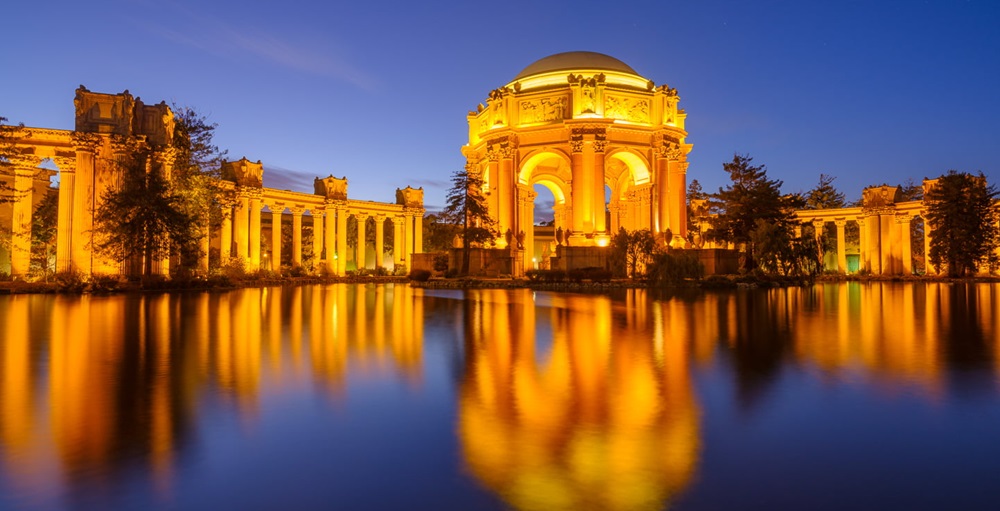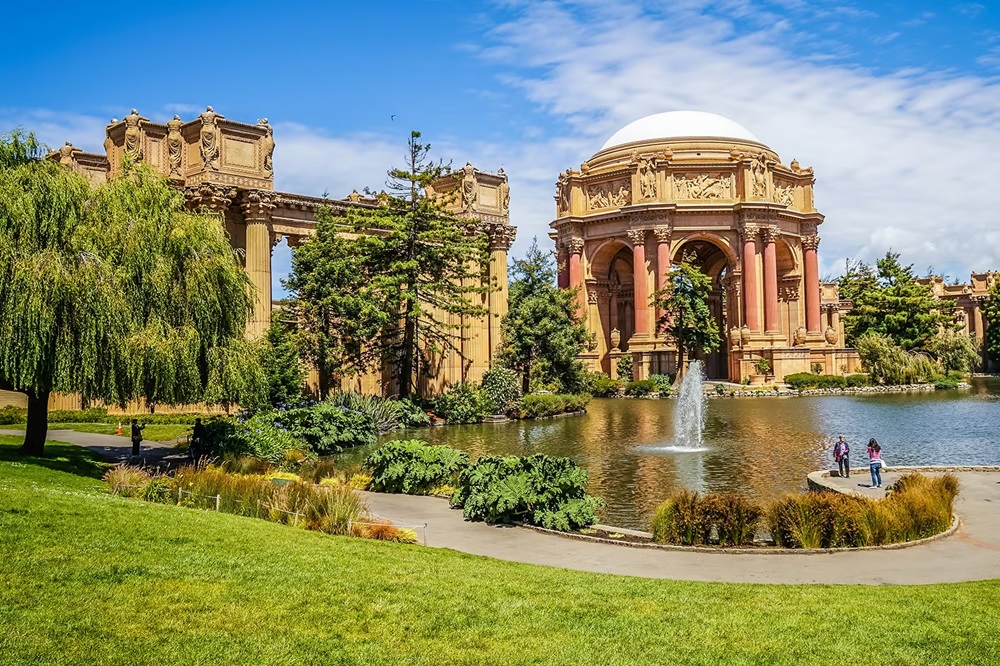The Palace of Fine Arts is a famous San Francisco, California landmark. It’s known for its stunning architecture, initially constructed for the 1915 Panama-Pacific Exposition. The palace features a classical Roman rotunda with curved colonnades and a peaceful lagoon. It’s a popular spot for visitors interested in art, architecture, and scenic beauty.
Initially built for the 1915 Panama-Pacific Exposition, it was a world’s fair that celebrated the construction of the Panama Canal and highlighted San Francisco’s recovery after the 1906 earthquake. The palace was created by architect Bernard Maybeck and is modelled after Greek and Roman structures. It has a large dome, colonnades, and a reflecting lagoon, making for a lovely scene.
The palace hosted performances and art exhibitions during the exposition, highlighting the value of culture and the arts in a world that is changing quickly. Even though it was only supposed to be a temporary building, San Franciscans and tourists alike grew to appreciate the Palace of Fine Arts, prompting efforts to save it following the exposition.
To guarantee the palace’s continued existence as a cultural landmark and a representation of San Francisco’s creative legacy, major restorations were made to it in the 1960s. The Palace of Fine Arts is now a popular tourist destination and a location for events, including concerts and exhibitions. It still serves as a representation of the city’s love of the arts and stunning architecture.
History of the Palace of Fine Arts
People in San Francisco have always had a particular place in their hearts for the Palace of Fine Arts. They saw its importance long before the historic preservation movement gained momentum, and they did so when the building was unusable. Above all, this highlights the site’s power and beauty and demonstrates the history of preservation cultivated by community pride and affection for the Palace of Fine Arts and everything it stood for, transforming the location from a dilapidated relic into a treasured asset.
The history of the Palace is a far more complex issue. In many ways, the Palace of Fine Arts story reflects the story of 20th-century San Francisco. The first chapter examines the career of Palace of Fine Arts architect Bernard Maybeck. Maybeck designed the Palace of Fine Arts for the Panama-Pacific International Exposition (PPIE) in 1915. Still, while this is one of his best-known works, it is only the tip of the iceberg regarding his influence on architecture in the Bay Area and beyond.

The Palace of Fine Arts preservation effort is highly significant nationally as it coincides with the growth of the preservation movement in America. It was an early example of a large-scale project gaining funding primarily through community support. Many see the demolition of Penn Station in New York City as a watershed in the development of Preservation in America by finally focusing attention on what could be lost without a dedication to historic sites. It is thus significant that while New York City was demolishing Penn Station, San Francisco was undertaking the detailed reconstruction of the Palace of Fine Arts, the rationale of which was more that of civic pride and historical and aesthetic respect than any pragmatic concerns.
As is often true with Bernard Maybeck, the story of how he came to design the most beloved and only surviving architectural composition of the PPIE is filled with contradictions and, at once, the culmination of random circumstances while also the result of fate. Of course, the true impetus for creating the Palace of Fine Arts was the Panama-Pacific International Exposition of 1915, an event once celebrating the connection of the Atlantic and Pacific and the independence and ability of the West, specifically the city of San Francisco. In many ways, it seems only fitting that Bernard Maybeck, a pioneer of an architectural style combining national design trends and a classical vocabulary with local materials and spirit, would create the crowning jewel of the Exposition, simultaneously celebrating these same ideas of current events, tradition, and the City of San Francisco.
Against the backdrop of the adjacent boisterous Fair, the Palace of Fine Arts faced the challenge of drawing guests and establishing the right ambience for art viewing. “Gradually transitioning from the exciting influences of the Fair to the quiet serenity of the galleries” was Maybeck’s stated goal. “Everyone’s favourite building was the Palace of Fine Arts,” says Ruth Newhall, describing Maybeck’s creative process for the Palace of Fine Arts. Maybeck had accomplished the unthinkable: he had begun with a feeling and skillfully conveyed it in concrete form.” Maybeck, ever the scholar, starts his examination of the Palace in a brochure released during the Fair by saying, “omitting construction, we shall just study the building as a conveyor of the Palace of Fine Arts Palace as “romantic, of the period after the Renaissance.”
A significant historical monument in San Francisco, California, is the Palace of Fine Arts Theatre. It was first built to house art exhibits during the Panama-Pacific Exposition 1915. Bernard Maybeck designed the building with a distinctive dome, colonnades, and classical architecture influenced by Greek and Roman architecture. The theatre is well known for its magnificent Beaux-Arts design. A vast dome, a lagoon, and several arcades are all part of the design, which produces a calm and beautiful setting.
The gorgeous building and scenic surroundings of San Francisco’s Palace of Fine Arts make for a great photographic location. With its abundant arches and elaborate decorations, the grand rotunda is a photographer’s dream—the columns around the lagoon provide dramatic and refined backgrounds. Reflections give the pictures a lovely touch, particularly when the structures are mirrored on the water’s surface. The lush, verdant scenery found in the gardens and walkways surrounding the palace makes a striking contrast to the traditional architecture.
Although the idea of an escape room in the Palace of Fine Arts is intriguing, this historic location must have its own escape room. Nonetheless, there are several immersive escape rooms in San Francisco. The Palace of Fine Arts offers a singular and enchanting experience at night. The dramatic lighting emphasises the building, creating a lovely and tranquil ambience. The Palace is exquisitely illuminated at night, with lights highlighting the lake reflections, colonnades, and rotunda. This produces an eye-catching visual impact that is ideal for pictures.






